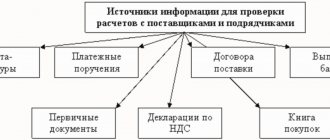Accounts receivable is one of the most significant indicators of financial statements. The write-off of accounts receivable is preceded by a lot of analytical and organizational work: identifying problematic accounts and debtors, and the possibility of debt collection. If it is impossible to collect the debt, it should be written off. At the same time, an accountant needs to know not only accounting and tax legislation, but the Civil Code and arbitration court practice.
Question: How to reflect in the accounting records of an organization that applies the simplified tax system (taxable object “income reduced by the amount of expenses”), the write-off of accounts receivable for goods sold due to the expiration of the statute of limitations? A provision for doubtful debts regarding this debt was not formed. As a result of an inventory of settlements with counterparties (based on the manager’s order), unsecured, overdue receivables were identified, for which the statute of limitations had expired. The amount of debt for the goods sold is 50,000 rubles. View answer
When counterparties' debts are considered bad
Bad receivables are an amount that an organization cannot collect from its counterparties due to certain reasons. For profit tax purposes, bad debts (debts that cannot be collected) are considered debts if at least one of the conditions listed in paragraph 2 of Article 266 of the Tax Code of the Russian Federation is met:
1. The established limitation period has expired. In general, this period is three years (clause 1 of Article 196 of the Civil Code of the Russian Federation). The limitation period begins to run from the moment when a person learned or should have learned about a violation of his right (Article 200 of the Civil Code of the Russian Federation). The limitation period is interrupted if the debtor commits actions indicating recognition of the debt (Article 203 of the Civil Code of the Russian Federation). After the break, the limitation period begins to run again, but it cannot exceed ten years (clause 2 of Article 196 of the Civil Code of the Russian Federation).
Thus, accounts receivable may not be recognized as uncollectible for a long time.
2. The debtor’s obligation is terminated due to the impossibility of its fulfillment on the basis of an act of a state body or the liquidation of an organization.
3. There is a resolution of the bailiff on the completion of enforcement proceedings, confirming the impossibility of collecting debts. In this case, the writ of execution must be returned to the claimant on the following grounds:
- it is impossible to establish the location of the debtor, his property or to obtain information about the availability of funds and other valuables belonging to him;
- the debtor does not have property that can be foreclosed on.
Starting from 2021, the amount of doubtful accounts receivable in relation to each counterparty should be determined minus accounts payable to this counterparty, and the maximum amount of the reserve at the end of the reporting period should be calculated as the greater of two values: 10% of revenue for the given reporting period or for the previous year *. To learn how these changes are supported in the 1C:Accounting 8 program (rev. 3.0), read the article Provision for doubtful debts: accounting in 1C:Accounting 8.
If there are several grounds for recognizing a receivable as bad (for example, the expiration of the statute of limitations and the liquidation of the debtor organization), then the debt is considered bad in the tax (reporting) period in which the first basis for recognizing the debt as bad took place (letter Ministry of Finance of Russia dated June 22, 2011 No. 03-03-06/1/373).
In the Regulations on accounting and reporting in the Russian Federation, approved. By order of the Ministry of Finance of Russia dated July 29, 1998 No. 34n (hereinafter referred to as the Regulations), only receivables with an expired statute of limitations are explicitly named as debts that are unrealistic for collection (clause 77 of the Regulations).
However, in practice, the criteria for recognizing debts as bad, which are named in paragraph 2 of Article 266 of the Tax Code of the Russian Federation, are also applied for accounting purposes.
Documenting
There are no legal requirements for registration of reconciliations. In already established practice, this procedure occurs by signing a reconciliation act for mutual settlements. In this document, the parties include all transactions that were carried out by them during the reconciled period, indicating the dates of their completion, the amounts of transactions, links to supporting documents, the amount of debt of each party is displayed and, if any, discrepancies between the data are recorded.
The form is developed by each organization and approved as an appendix to the accounting policy. In addition, in automated accounting programs this form is already programmed and the report is generated automatically when you select the desired counterparty, specific contracts (if necessary) and specify the reconciliation period.
The procedure for writing off bad debts...
... in accounting
Accounts receivable recognized as uncollectible (uncollectible) are written off for each obligation on the basis of inventory, written justification and order (instruction) of the head of the organization (clause 77 of the Regulations). If in the period preceding the reporting period, the amounts of such debts were not reserved in the manner prescribed by clause 70 of the Regulations, then they are attributed to the financial results of a commercial organization or to an increase in expenses of a non-profit organization (clause 77 of the Regulations, letter of the Ministry of Finance of Russia dated January 14, 2015 No. 07-01-06/188). Please note that according to the Regulations, since 2011, the formation of a reserve for doubtful debts is the responsibility of the organization.
It should be borne in mind that writing off a debt at a loss due to the insolvency of the debtor does not constitute cancellation of the debt. This debt must be reflected on the balance sheet for five years from the date of write-off in order to monitor the possibility of its collection in the event of a change in the debtor’s property status (paragraph 2 of clause 77 of the Regulations).
The amount of debt written off is recorded in off-balance sheet account 007 “Debt of insolvent debtors written off at a loss.” If the debtor makes payment on a previously written off debt, it should be reflected as part of the organization’s other income (clauses 4, 7 of PBU 9/99 “Organization’s Income”, approved by order of the Ministry of Finance of Russia dated May 6, 1999 No. 32n).
We remind you that in the balance sheet the balances of account 63 “Provisions for doubtful debts” are not shown, and the amount of receivables for which the reserve is formed is reflected minus the amount of the reserve. At the same time, retained earnings are reduced by the same amount (Chart of accounts for accounting of financial and economic activities of organizations and Instructions for its application, approved by order of the Ministry of Finance of Russia dated October 31, 2000 No. 94n, clause 35 of PBU 4/99 “Accounting statements of an organization”, approved by order of the Ministry of Finance of Russia dated July 6, 1999 No. 43n). In the statement of financial results, deductions to reserves for doubtful debts are reflected as part of other expenses (clause 11 of PBU 10/99 “Expenses of the organization,” approved by order of the Ministry of Finance of Russia dated May 6, 1999 No. 33n). Thus, writing off debts through the reserve does not affect the financial statements.
... in tax accounting
Amounts of receivables for which the statute of limitations has expired or the collection of which is impossible are considered uncollectible and are written off in full, including VAT (letters of the Ministry of Finance of Russia dated July 24, 2013 No. 03-03-06/1/29315, dated June 11, 2013 No. 03 -03-06/1/21726).
The taxpayer may create reserves for doubtful debts in the manner established by Article 266 of the Tax Code of the Russian Federation.
Please note that only receivables from a counterparty associated with the sale of goods, performance of work, or provision of services can be recognized as doubtful debt for the purposes of creating reserves in tax accounting. Amounts of deductions to reserves for doubtful debts are included in non-operating expenses on the last day of the reporting (tax) period and, accordingly, reduce the tax base for this period (clause 7, clause 1, article 265 of the Tax Code of the Russian Federation, clause 3, article 266 of the Tax Code of the Russian Federation ).
If the taxpayer has decided to create a reserve for doubtful debts, then the write-off of bad debts is carried out at the expense of the amount of the created reserve (clause 4 of Article 266 of the Tax Code of the Russian Federation).
If such a reserve was not created, or the amounts of bad debts are not covered by the reserve, then they are included in non-operating expenses (clause 2, clause 2, article 265, clause 5, article 266 of the Tax Code of the Russian Federation).
At the same time, debts that are not related to the sale of goods (works, services) can also be recognized as bad debts, for example:
- the amount of the advance payment transferred to the supplier against the upcoming delivery of goods (letter of the Ministry of Finance of Russia dated September 4, 2015 No. 03-03-06/2/51088);
- the amount of debt under the loan agreement (letters of the Ministry of Finance of Russia dated July 16, 2015 No. 03-03-06/3/40956, dated April 24, 2015 No. 03-03-06/1/23763).
How should a taxpayer write off debts of this type? The Resolution of the Presidium of the Supreme Arbitration Court of the Russian Federation dated June 17, 2014 No. 4580/14 sets out the position according to which a bad debt that arose not in connection with the sale of goods (works, services) cannot participate in the formation of a reserve for doubtful debts (clause 1 of Article 266 Tax Code of the Russian Federation), therefore cannot be written off from the reserve. Such debt can be taken into account as part of non-operating expenses when calculating the income tax base in accordance with subparagraph 2 of paragraph 2 of Article 265 of the Tax Code of the Russian Federation.
The date of recognition of non-operating expenses in tax accounting is established by paragraph 7 of Article 272 of the Tax Code of the Russian Federation. Bad debts for which the statute of limitations has expired are taken into account on the last day of the reporting period in which the statute of limitations expires (letter of the Ministry of Finance of Russia dated 02/06/2015 No. 03-03-06/1/4995, dated 01/28/2013 No. 03-03-06/1/38).
If the amounts of reserves accrued in accounting and tax accounting differ, then differences arise in the assessment of income and expenses recorded in account 91 “Other income and expenses” and, as a consequence, profits and losses recorded in account 99 “Profits and losses” . In accordance with the Accounting Regulations “Accounting for income tax calculations”, approved. by order of the Ministry of Finance of Russia dated November 19, 2002 No. 114n (hereinafter referred to as PBU 18/02), these differences are permanent. Permanent differences recorded in account 99 are taken into account when calculating income tax for the corresponding period: a permanent tax liability (PNO) or a permanent tax asset (PNA) is recognized.
In the income tax return (approved by order of the Federal Tax Service of Russia dated October 19, 2016 No. ММВ-7-3/ [email protected] ), losses from writing off bad debts are reflected in Appendix No. 2 to Sheet 02:
- on line 302 “amounts of bad debts, and if the taxpayer has decided to create a reserve for doubtful debts, amounts of bad debts not covered by the reserve funds”;
- in the total amount for line 300 “Losses equated to non-operating expenses - total.”
Postings
One of the most common cases when it is necessary to write off short-term contracts at an enterprise is to write off debt to suppliers and contractors who have already provided their services to the company. To do this, the accountant needs posting D 60 K 91-1.
The “creditor” based on the prepayment received is written off by posting D 62 K 91-1 . It also writes off deliveries that were not sold.
D 76 K 91-1 – entry for writing off debt to company personnel . It is also used when there is an overspending of funds issued by the authorities to the accountable person. The accountant uses it to write off bonuses or part of wages that were not issued to employees for any reason.
For settlements with company employees, account 70 is used . Posting for settlements with officially employed employees D 70 K 84.
D 71 K 91-1 – entry for writing off short-term payments due to overspending from accountable persons.
Write-off of accounts payable for settlements with shareholders who are not on the staff of the enterprise, posting D 75-2 K 84 is used.
Write-off of bad receivables in 1C:Accounting 8
Let's look at how “1C: Accounting 8” (rev. 3.0) reflects transactions to write off bad receivables.
Example 1
The organization Modern Technologies LLC applies the general taxation system, the provisions of PBU 18/02, and pays VAT. As of March 1, 2017, Modern Technologies LLC has an outstanding buyer debt in the amount of RUB 150,000.00. (including VAT 18%), as well as accrued reserves in relation to this debt:
Due to the expiration of the statute of limitations, the specified debt was rightfully recognized as uncollectible (uncollectible) and written off in March 2021. |
Reconciliation period
The parties themselves agree on the period for which they will check.
To confirm accounts receivable and accounts payable in the annual balance sheet, you need to reconcile the calendar year.
It is possible that reconciliations with the counterparty have already been carried out, in which case the period for the new one begins when the previous one ended. In this case, the debt from the previous one will be reflected as a debt at the beginning of a new reconciliation.
If the parties have been cooperating for several years under several contracts, and the need for reconciliation has arisen only in the current period, it can be carried out in several stages to facilitate the process.
Inventory of calculations
To check the amounts of receivables, as well as compare the reserves for doubtful debts accrued in accounting and tax accounting, we will use the Subconto Analysis report (Reports section).
In the command panel of this report, you need to set the period for generating the report, and from the presented list of subconto types, select the value Contracts. In the settings panel (Show settings button) on the Indicators tab, set the BU (accounting data) and NU (tax accounting data) flags.
On the Selection tab, you can set selection for a specific agreement with the debtor.
The generated report allows you to analyze accounting and tax accounting data for the selected agreement at the time of expiration of the limitation period with details of the accounts (Fig. 1).
Rice. 1. Analysis of the subconto under the agreement with the debtor
Before performing an operation to write off a bad debt, it is necessary to draw up an inventory of settlements. The program uses the document Inventory of Payments document for this purpose, which can be accessed via the hyperlink of the same name from the Sales and Purchases sections.
The document is filled out automatically by clicking the Fill button based on accounting data. The tabular part on the Accounts Receivable tab (Fig. 2) is filled in with the balances of accounts receivable as of the inventory date as follows:
Table 1
| Field | Data |
| "Counterparty" | Names of debtors |
| "Settlement account" | Accounts for which accounts receivable are recorded |
| "Total" | Accounts receivable amount |
| "Confirmed" | The amount for which there is documentary evidence. By default, all debt is considered confirmed |
| "Not confirmed" | An amount for which there is no documentary evidence. This field must be filled in manually |
| “Incl. the statute of limitations has expired" | The amount of overdue receivables for which the statute of limitations has expired. This field must be filled in manually |
Rice. 2. Inventory report of settlements
The tabular part on the Accounts Payable tab is filled out in the same way as filling out the Accounts Receivable tab. Under the terms of Example 1, there are no accounts payable.
The Settlement Accounts tab displays a list of accounts for settlements with counterparties for which an inventory of settlements is performed.
By default, the following accounts are included in this list:
- 60 “Settlements with suppliers and contractors”;
- 62 “Settlements with buyers and customers”;
- 66 “Settlements for short-term loans and borrowings”;
- 67 “Settlements for long-term loans and borrowings”;
- 76 “Settlements with various debtors and creditors”, including accounts 76.07 “Settlements for rent”, 76.27 “Settlements for rent (in foreign currency)” and 76.37 “Settlements for rent (in cu)”;
- 58 “Financial investments”.
The user can manage the list of accounts by adding other accounts or disabling accounts suggested by the program.
On the Inventory bookmark, in the appropriate fields, you should indicate the timing of the inventory, details of the basis document, as well as the reason for conducting the inventory of calculations.
On the Inventory Commission tab, you need to fill out the list of commission members by selecting them from the Individuals directory.
The chairman of the commission is indicated using a flag in the Chairman field.
The document Calculation Inventory Act does not generate transactions, but allows you to generate the following printed forms of documents (Print button):
- Order to conduct an inventory (INV-22);
- Inventory report of settlements (INV-17).
Sample of drawing up an order
This document is drawn up on the company's letterhead with a seal and signed by the director . The text of the order must contain references to the documents on the basis of which it was drawn up. This is an accounting certificate and an inventory act. They justify the existence of a debt and the legality of its removal.
The text of the order contains references to the regulations that serve as the basis for its preparation (acts of the Civil and Tax Codes), the rationale for debt removal, as well as the position of the employee who is responsible for the implementation of the document.
Important! The order, inventory act and accounting certificate must be kept in the company’s accounting department for 5 years.
You can download an example of such a document on our website.
Write-off of buyer's debt
Under the conditions of Example 1, the amount of accrued reserves in accounting and tax accounting differs.
In accounting, there is a bad debt in the amount of RUB 150,000.00. We will write it off completely from the reserve. In tax accounting, only 100,000.00 rubles will be written off from the reserve, and the remaining debt in the amount of 50,000.00 rubles, not covered by the reserve, will be included in non-operating expenses.
To write off bad debt using reserves, you can use the standard document of the Debt Adjustment program (Fig. 3). This document is available both from the Sales and Purchases sections.
The header of the Debt Adjustment document must be filled out by selecting the following values from the proposed lists:
table 2
| Field | Data |
| "Type of operation" | Debt write-off |
| "Write off" | Buyer's debt |
| "Buyer (debtor)" | Name of the debtor organization for which the amount of receivables recognized as bad is listed (selected from the “Counterparties” directory) |
The document is filled out automatically by clicking the Fill -> Fill in balances for mutual settlements based on accounting data. The tabular part on the Buyer's debt (accounts receivable) tab is filled in with the balances of mutual settlements as of the adjustment date as follows:
Table 3
| Field | Data |
| "Settlement amount" | Total amount of debt (RUB 150,000.00) |
| "Sum" | The amount of debt write-off in accounting. By default, this amount corresponds to the total amount owed |
| "Amount NU" | The amount of debt write-off in tax accounting. By default, this amount also corresponds to the total amount owed. Since this document will write off the debt from the reserve, it is necessary to manually correct the amount in the “Amount NU” field (RUB 100,000.00) |
| "Account" | Account on which the debt arose (62.01) |
On the Write-off account tab, you need to indicate the account where the doubtful receivables will be allocated (63 “Provisions for doubtful debts”), as well as the details of the agreement with the counterparty and the settlement document on which the doubtful receivables were generated (see Fig. 3).
Rice. 3. Write-off of bad receivables using reserves
After posting the document, an accounting entry will be generated:
Debit 63 Credit 62.01 - for the amount of debt written off from the reserve created in accounting (RUB 150,000.00).
For tax accounting purposes for income tax, amounts are entered into special resources of the accounting register:
Amount NU Dt 63 and Amount NU Kt 62.01 - for the amount of debt written off at the expense of the reserve created in tax accounting (RUB 100,000.00). Amount PR Dt 63 and Amount PR Kt 62.01 - for a constant difference, the value of which is RUB 50,000.00.
For profit tax purposes, the remaining portion of the bad debt is written off as non-operating expenses using the Transaction document (section Transactions -> Accounting -> Transactions entered manually). In the document form, to create a new transaction, click the Add button and enter the amounts in the special resources of the accounting register (the Amount field must remain empty):
Amount NU Dt 91.02 and Amount NU Kt 62.01 - for the amount of written off debt not covered by the reserve (RUB 50,000.00). Amount PR Dt 91.02 and Amount PR Kt 62.01 - for a negative constant difference (-50,000.00 rub.). When performing the routine operation Calculation of income tax for March, which is included in the Closing of the month processing, this permanent difference leads to the recognition of a permanent tax asset in the amount of RUB 10,000.00.
Please note that in order to correctly fill out the income tax return, it is important to correctly select the item of other income and expenses - Write-off of accounts receivable (payable). Then, when automatically filling out the income tax return for the first quarter of 2021, losses from writing off bad debts in the amount of RUB 50,000.00. will be reflected on line 302 of Appendix No. 2 to Sheet 02, as well as in the total amount on line 300 of Appendix No. 2 to Sheet 02.
To make sure that bad debts are written off in accounting and tax accounting, you can generate a balance sheet for account 62 for March 2021, having previously made the appropriate settings on the Indicators tab. The balance sheet generated under account 63 for March 2021 will show the absence of reserves for doubtful debts.
To account for written-off debt in order to monitor the possibility of its collection (in accordance with paragraph 2 of clause 77 of the Regulations), we will also use the Operation document.
In the document form, to create a new transaction, you need to click the Add button and enter an entry in the amount of RUB 150,000.00. on the debit of off-balance sheet account 007 indicating the corresponding analytics (sub-account Counterparties and Agreements).
Results
The process of writing off accounts receivable is simple, but strictly regulated. Violation of it is fraught with claims from tax inspectors and additional assessment of income tax or fines for accounting errors. Therefore, before writing off receivables, make sure that an inventory has been taken and the appropriate order has been issued.
However, we still advise you not to increase the company’s expenses by writing off receivables and to make every effort to liquidate the counterparty’s receivables, offering him, for example, an installment plan or debt restructuring.
You can find more complete information on the topic in ConsultantPlus. Free trial access to the system for 2 days.









